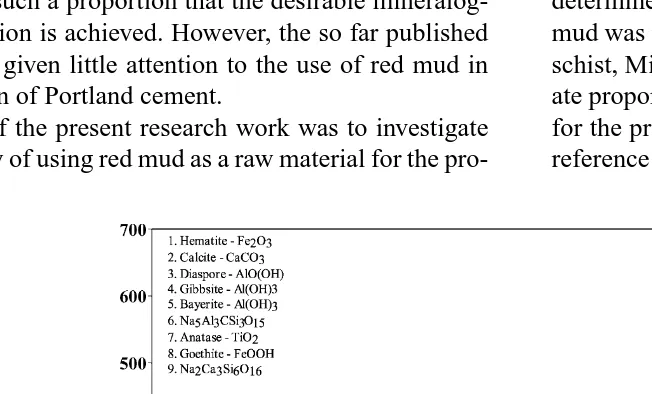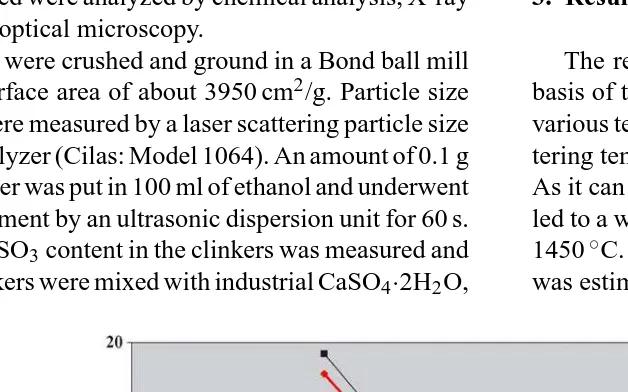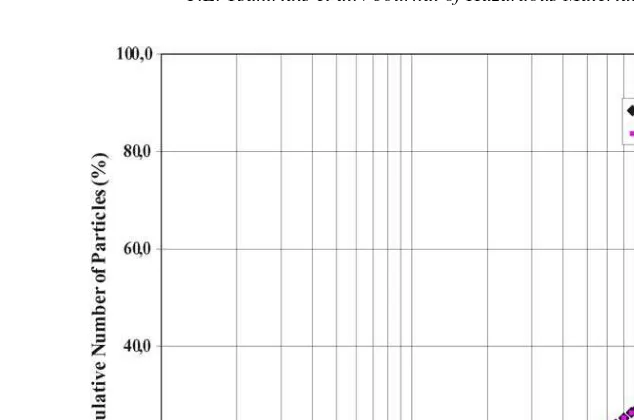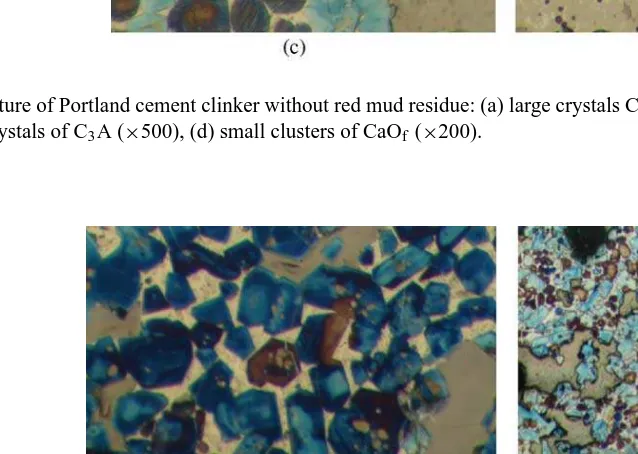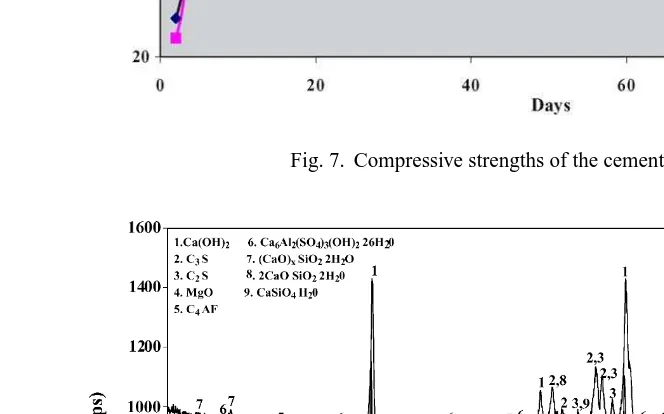See discussions, stats, and author profiles for this publication at: https://www.researchgate.net/publication/8166696
Red Mud Addition in the Raw Meal for the
Production of Portland Cement Clinker
Article in Journal of Hazardous Materials · January 2005
DOI: 10.1016/j.jhazmat.2004.08.002 · Source: PubMed
CITATIONS
118
READS
756
3 authors, including:
Petros E Tsakiridis
National Technical University of Athens
66PUBLICATIONS 1,228CITATIONS
SEE PROFILE
Styliani Agatzini -Leonardou
National Technical University of Athens
33PUBLICATIONS 665CITATIONS
SEE PROFILE
All content following this page was uploaded by Petros E Tsakiridis on 27 November 2016.
Red mud addition in the raw meal for the production of
Portland cement clinker
P.E. Tsakiridis
∗, S. Agatzini-Leonardou, P. Oustadakis
Department of Mining and Metallurgical Engineering, Laboratory of Metallurgy, National Technical University of Athens, Greece 9, Iroon Polytechniou Street, 15780 Zografou, Athens, Greece
Received 9 July 2004; received in revised form 1 August 2004; accepted 2 August 2004 Available online 22 October 2004
Abstract
The aim of the present research work was to investigate the possibility of adding red mud, an alkaline leaching waste, which is obtained from bauxite during the Bayer process for alumina production, in the raw meal for the production of Portland cement clinker. For that reason, two samples of raw meals were prepared: one with ordinary raw materials, as a reference sample ((PC)Ref), and another with
3.5% red mud ((PC)R/M). The effect on the reactivity of the raw mix was evaluated on the basis of the unreacted lime content in samples
sintered at 1350, 1400 and 1450◦C. Subsequently, the clinkers were produced by sintering the two raw meals at 1450◦C. The results of chemical and mineralogical analyses as well as the microscopic examination showed that the use of the red mud did not affect the mineralogical characteristics of the so produced Portland cement clinker. Furthermore, both clinkers were tested by determining the grindability, setting time, compressive strength and expansibility. The hydration products were examined by XRD analysis at 2, 7, 28 and 90 days. The results of the physico-mechanical tests showed that the addition of the red mud did not negatively affect the quality of the produced cement.
© 2004 Elsevier B.V. All rights reserved.
Keywords: Red mud; Sintering; Cement; Hydration
1. Introduction
The general trend of today for the industrial wastes or by-products, which are produced in industrial countries, is to examine alternative ways for their exploitation in order to eliminate cost of disposal and avoid soil and water con-tamination. Many of these undesirable industrial materials contain significant amounts of inorganic ingredients, such as oxides of silicon, aluminum, calcium and iron, which, at suit-able combinations, can be used in the production of Portland cement clinker.
Red mud is produced during the digestion of bauxite with sodium hydroxide. It generally exits the process stream as a highly alkaline slurry (pH 10–12.5) with 15–30% solids
[1–4] and it is pumped away for appropriate disposal. It
∗Corresponding author. Tel.: +30 210 7722234; fax: +30 210 7722218.
E-mail address: [email protected] (P.E. Tsakiridis).
is a complex material whose chemical and mineralogical composition varies widely, depending upon the source of bauxite and the technological process parameters. It con-tains six major constituents, namely Fe2O3, A12O3, SiO2,
TiO2, Na2O and CaO and small quantities of numerous
mi-nor/trace elements (as oxides) such as V, Ga, Cr, P, Mn, Cu, Cd, Ni, Zn, Pb, Mg, Zr, Hf, Nb, U, Th, K, Ba, Sr, rare earths, etc. Every red mud is composed of as many as 14–21 mineral phases[5–9]. Its brick red color is due to the iron oxides.
At all the world’s 85 alumina plants, 1.0–1.6 tonnes of red mud is generated per tonne of alumina and it is estimated that over 66 million tonnes of this waste is impounded annually in the world. The disposal of such a large quantity of this alkaline waste sludge is expensive (up to 1–2% of the alumina price), as it requires a lot of land (approximately 1 km2per 5 years for a 1 Mtpy alumina plant) and causes a number of environmental problems[1].
104 P.E. Tsakiridis et al. / Journal of Hazardous Materials B116 (2004) 103–110
In Greece, the bauxitic red mud from the alumina pro-cessing plant is discharged, through a pipe line, at a rate of 500,000 tons/year into Antikyra Bay, on the northern shore line of the central Gulf of Corinth. At the outfall the red mud slurry has a concentration of 500 g/l and bulk density of 1.3 g/l[10–11]. The fine character of the metal-rich red mud, coupled with the shallow water at the dumping site, leads to great dispersion of the material and its transport over long distances. Thus, significant amounts of toxic metals, associ-ated with the bauxitic red mud, are dispersed in the Gulf of Corinth.
It is well known that various industrial wastes, such as met-allurgical slags, fly ash, glass, ceramics from the electronic industry, spent catalysts from refineries, sludge from waste water treatment and others, have been successfully used in clinker production[12–14]. These materials are added to the feedstock in such a proportion that the desirable mineralog-ical composition is achieved. However, the so far published literature has given little attention to the use of red mud in the production of Portland cement.
The aim of the present research work was to investigate the possibility of using red mud as a raw material for the
pro-Fig. 1. Mineralogical phases of red mud.
Table 1
Chemical analysis of raw materials for the production of Portland cement clinkers
Oxides Content of raw materials (%)
Limestone Schist Bauxite Milos sand Iron sand Red mud
SiO2 0.25 52.62 17.58 93.66 1.88 6.80
duction of a typical Portland cement clinker. For that reason, two samples of raw meals were prepared, one with ordinary raw materials, as a reference sample ((PC)Ref), and another
with 3.5% red mud ((PC)R/M). The produced clinkers were
analyzed chemically and minerlogically by XRD and opti-cal microscopy. The clinkers were then mixed with gypsum and the final cements samples were tested for grindability, setting times, compressive strengths and expansibility. The hydration products were determined by XRD analysis at the ages of 2, 7, 28 and 90 days.
2. Experimental
Uncausticised red mud from Aluminum de Grece was used as received and its mineralogical phases, which were determined by XRD analysis, are given inFig. 1. The red mud was mixed with other raw materials, such as limestone, schist, Milos sand, ironferous sand and bauxite, in appropri-ate proportions in order to produce the raw meal to be tested for the production of Portland cement clinker ((PC)R/M). A
Table 2
Composition of the raw meals for the production of Portland cement clinkers
Raw meals Raw meals composition (%)
Limestone (%) Schist (%) Bauxite (%) Milos sand (%) Iron sand (%) Red mud (%)
(PC)Ref 75.28 14.30 4.50 5.73 0.20 0.00
(PC)R/M 74.80 11.40 3.00 7.30 0.00 3.50
synthesized for reasons of comparison. The chemical anal-yses of the raw materials used are given inTable 1. Based on those, and by using a computational software program, the syntheses of the two raw meals were derived and are pre-sented inTable 2.
The effect on the burnability was evaluated on the basis of the unreacted lime content in samples sintered at 1200, 1350, 1400 and 1450◦C for 20 min in an electrical furnace
and cooled rapidly in air. The unreacted lime (free lime) was determined according to the standard ethylene glycol method. The sintering process applied was common for the produc-tion of both types of cement clinkers. The raw meals were shaped in small spheres, with a diameter of 2 cm, and dried at 110◦C. Then, they were placed inside an oven at 500◦C, the temperature was increased to 1000◦C, at which the samples remained for 30 min, and finally, the temperature was further increased to 1450◦C. At the end of the sintering process, the samples were removed from the oven and left to cool inside a dryer in order to avoid the effects of air and moisture. The clinkers produced were analyzed by chemical analysis, X-ray diffraction and optical microscopy.
The clinkers were crushed and ground in a Bond ball mill to a specific surface area of about 3950 cm2/g. Particle size distributions were measured by a laser scattering particle size distribution analyzer (Cilas: Model 1064). An amount of 0.1 g of sample powder was put in 100 ml of ethanol and underwent dispersion treatment by an ultrasonic dispersion unit for 60 s. The soluble SO3content in the clinkers was measured and
the ground clinkers were mixed with industrial CaSO4·2H2O,
Fig. 2. Free lime at various temperatures for raw mixes with and without red mud.
so that the produced laboratory cements contained about 2.5% total soluble SO3.
Compressive strength measurements were conducted at the ages of 2, 7, 28 and 90 days on mortar prisms (dimensions 40 mm×40 mm×160 mm), prepared and tested in accor-dance with European Standard EN 196-1[15]. The normal consistency and setting times of cement pastes were deter-mined using a Vicat apparatus according to the European Standard EN 196-3[16]. Expansions of the cement pastes were determined the by Le Chatelier method.
For the study of the hydration products, the cement pastes were prepared by mixing 300 g of ground mixtures with 75 ml of water. They were then cured in tap water at a tempera-ture 20 ±2◦C. At the ages of 2, 7, 28 and 90 days, the hydration was stopped by means of acetone and ether extrac-tion and the hydraextrac-tion products were determined by XRD analysis.
3. Results and discussion
The reactivity of the raw mixtures was evaluated on the basis of the unreacted lime (CaOf) content after sintering at
various temperatures. The CaOfcontent in relation to the
106 P.E. Tsakiridis et al. / Journal of Hazardous Materials B116 (2004) 103–110
Fig. 3. Particle size distributions of cement samples by a laser scattering analyzer.
Fig. 4. X-ray diffraction of Portland cement clinkers with and without red mud residue.
The chemical analysis and the potential mineral com-position of the Portland clinkers produced are given in
Tables 3 and 4, respectively. As the tables show, the addi-tion of the red mud residue by 3.5% did not seem to affect its mineralogical composition.
The clinkers were coground with 5% (w/w) gypsum in a ball mill of 1.5 kg capacity. The gypsum was of industrial origin (98%, w/w, Ca2SO4·2H2O, 46.7%, w/w, SO3). The
results of particle size distributions by a laser scattering an-alyzer are given in Fig. 3. The grindability index of each sample was determined and is presented in Table 5. Both cement samples gave similar results.
The XRD analyses of the produced Portland clinkers are given inFig. 4. As can be seen, the addition of the 3.5 residue did not affect the mineralogical composition of the produced clinker. In both clinker types, the main mineralogical phases, C3S, C2S, C3A and C4AF, were well formed. The (PC)R/M
Table 3
Chemical analysis of the Portland cement clinkers
Oxides Content of the produced cement clinkers (%)
(PC)Ref (PC)R/M
SiO2 21.24 20.80
Al2O3 4.61 4.87
Fe2O3 3.23 3.87
CaO 66.52 65.78
MgO 2.27 2.40
K2O 0.42 0.43
Na2O 0.35 0.36
SO3 0.30 0.35
TiO2 0.28 0.54
CaOf 2.30 1.95
Fig. 5. Microstructure of Portland cement clinker without red mud residue: (a) large crystals C3S, cluster C2S (×500), (b) finger C2S because of slow cooling
(×500), (c) fine crystals of C3A (×500), (d) small clusters of CaOf(×200).
Fig. 6. Microstructure of Portland cement clinker with red mud residue: (a) well-formed alite crystals (×500), (b) crystals C2S scattering among alite (×100),
(c) high percentage of C4AF (×500), (d) CaOfscattering among alite (×500).
clinker contained more C3A and less C4AF than the (PC)Ref
clinker. These differences were attributed to the partial re-placement of schist and bauxite with red mud, which is higher in iron aluminum than the former. CaOfwas relatively higher
in the reference synthesis, probably due to its higher content of CaO.
The microstructure of the Portland cement clinkers was examined by optical microscopy in polished sections. The addition of the red mud residue by 3.5% did not seem to affect its microstructure and the formation of its
character-istic mineralogical phases (Figs. 5 and 6). CaOf was
dis-persed among other phases, in low percentages, especially in the (PC)R/M synthesis. Both clinkers contained more or
less euhedral alite and they exhibited coalescence of alite crystals. In the case of (PC)R/M, the alite crystals appeared
well formed, with size 40m, whereas no decomposition of
C3S was observed. On the other hand, the size of C3S, in
the case of (PC)Ref, was about 45m. In the optical
microstruc-108 P.E. Tsakiridis et al. / Journal of Hazardous Materials B116 (2004) 103–110
Fig. 7. Compressive strengths of the cements produced.
Fig. 8. X-ray diffraction of (PC)Refpastes at 2, 7, 28 and 90 days.
ture of belite between (PC)Refand (PC)R/Mclinkers were
de-tected, except that the (PC)Ref sample, occasionally, showed
finger C2S, apparently because of slow rate of cooling. In
the reference clinker, the belite crystals existed mainly in nests and appeared as clusters. In the (PC)R/M clinker,
be-lite crystals were few and evenly distributed in relation to alite, indicating that the clinkering reaction had proceeded extensively in the direction of alite and that the raw mix was much more homogenous. Finally, in the (PC)R/Mclinker, the
liquid phase occurred as uniformly distributed fine crystals, whereas, in the case of (PC)Ref, large crystals of C3A were
observed.
The water requirement and setting time, determined by Vicat probe and Vicat needle apparatus, as well as the results of expansion are reported inTable 6. The obtained values
showed that the use of red mud in the raw meal only slightly affected the water content for standard consistency and the setting times. The expansion measured, according to the Le Chatelier process, was well below the maximum accepted value of 10 mm (EN 197-3).
Table 4
Mineralogical composition of the produced Portland cement clinkers
Mineralogical phases Cement clinkers composition (%)
(PC)Ref (PC)R/M
C3S 63.50 61.91
C2S 13.08 13.02
C3A 6.76 6.37
Fig. 9. X-ray diffraction of (PC)R/Mpastes at 2, 7, 28 and 90 days.
Table 5
Results of grindability tests
Number of sample (PC)Ref (PC)R/M
Mill revolutions 4150 4100
Specific surface (Blaine, cm2/gr) 3950 3960
Grindability index 0.95 0.97
Specific gravity (g/cm2) 3.12 3.14
SO3(%) 2.45 2.40
The mortars of the samples under investigation were tested for compressive strengths after 2, 7, 28 and 90 days of cur-ing. The obtained results are shown in Fig. 7. The mor-tar, which contained the (PC)R/Mclinker, showed relatively
higher compressive strengths than the (PC)Ref, especially at
the ages of 28 and 90 days. This fact confirms the proba-bility of the red mud utilization in the raw meal for cement production.
The XRD patterns of the (PC)Ref and (PC)R/M samples,
hydrated at 2, 7, 28 and 90 days, are presented inFigs. 8 and 9, respectively. In both cases, the diffraction peaks of ettringite, CSH and Ca(OH)2appeared in all samples obtained during
hydration. The peaks of the C3S and C2S phases diminish,
especially at the age of 90 days. The higher peaks of Ca(OH)2,
in the case of (PC)R/M, indicate a higher hydration rate than
the (PC)Refsample, at the ages of 2 and 7 days. Following the
hydration progress, through peaks of Ca(OH)2, at the ages of
28 and 90 days, it was possible to observe a higher intensity of these peaks in the case of (PC)R/M.
Table 6
Results of setting time and expansibility
Sample (PC)Ref (PC)R/M
Initial time (min) 145 150
Final time (min) 225 215
Water of normal consistency (%) 23.3 24.1
Expansion (mm) (Le Chatelier) 1.5 2.0
4. Conclusions
The addition of red mud residue by 1% in the raw meal did not affect either the sintering or the hydration process during Portland cement production. More specifically, the sample with red mud presented the following characteristics:
1. The alite phase occurred as small well-formed crystals. 2. The belite crystals were few and evenly distributed in
re-lation to alite, indicating that the clinkering reaction had proceeded extensively in the direction of alite and that the raw mix was homogenous.
3. The liquid phase occurred as fine crystals, uniformly dis-tributed.
4. The values for setting times, water content for standard consistency and expansion were similar to those obtained with the reference ordinary Portland cement sample. 5. The compressive strengths were at least as high as those
of the reference sample during hydration.
It is thus concluded that the red mud residue, produced during the digestion of bauxite with sodium hydroxide, can be utilized as a raw material in cement production, at no cost to the producer, contributing, in this way, to reduction of the process cost.
References
[1] A.R. Hind, S.K. Bhargava, S.C. Grocott, The surface chemistry of Bayer process solids: a review, Colloids Surf. A: Physicochem. Eng. Aspects 146 (1–3) 359–374.
[2] J. Zambo, K. Solymar, Prospects of phase transformations in the Bayer process, in: Proceedings of the 3rd International Congress on Study of Bauxites, Alumina and Aluminum, Nice, 1973, pp. 491–502.
110 P.E. Tsakiridis et al. / Journal of Hazardous Materials B116 (2004) 103–110
[4] S. Ostap, Effect of bauxite mineralogy on its processing character-istics, in: L. Jacob (Ed.), Proceedings of the Bauxite Symposium, 1984, Los Angeles, CA, 1984, pp. 651–671.
[5] P. Basu, Reactions of iron minerals in sodium aluminate solutions, in: Proceedings of the 112th AIME, Annual Meeting, Atlanta, GA, Light Met. (1983) 83–97.
[6] D.K. Grubbs, S.C. Libby, J.K. Rodenburg, K.A. Wefers, The geology mineralogy and clarification properties of red and yellow Jamaican bauxites, in: Proceedings of the Bauxite Symposium IV, J. Geol. Soc. Jamaica (1980) 176–186.
[7] V.G. Logomerac, The distribution of rare earths and other minor el-ements in Surinam bauxite and laterite and in the red mud obtained from them, in: Proceedings of the Seventh Guyana Geological Con-ference, Paramaribo, Suriname, Verh. K. Ned. Geol. Mijnbouwkd. Gen. 27 (1966) 155–162.
[8] K. Solymar, I. Sajo, J. Steiner, J. Zoldi, Characteristics and separa-bility of red mud, Light Met. (1992) 209–223.
[9] K.I. Verghese, The impact of impurities on the Bayer process, in: K. Biedfeldt, K. Grjotheim (Eds.), Bayer and Hall-Heroult Process-Selected Topics, Aluminium Verlag, Austria, 1988, pp. 42–46.
[10] S.E. Poulos, M.B. Collins, C. Pattiaratchi, A. Cramp, W. Gull, M. Tsimplis, G. Papatheodorou, Oceanography and sedimentation in the semi-enclosed, deep-water Gulf of Corinth (Greece), Mar. Geol. 134 (3–4) (1996) 213–235.
[11] S.P. Varnavas, P.P. Achilleopoulos, Factors controlling the vertical and spatial transport of metal-rich particulate matter in seawater at the outfall of bauxitic red mud toxic waste, Sci. Total Environ. 175 (1995) 199–205.
[12] F.M. Lea, The Chemistry of Cement, third ed., Edward Arnold Pub-lishers, 1970.
[13] J.H. Potgieter, K.A. Horne, S.S. Potgieter, W. Wirth, An evaluation of the incorporation of a titanium dioxide producer’s waste mate-rial in Portland cement clinker, Mater. Lett. 57 (1) (2002) 157– 163.
[14] M. Singh, et al., Preparation of iron rich cements using red mud, Cement Concrete Res. 27 (7) (1997) 1037–1046.
[15] EN 196-1, Methods of testing cement – determination of compressive strength (1994).
